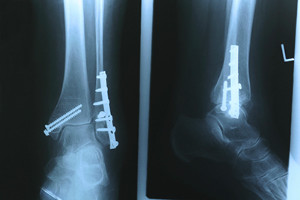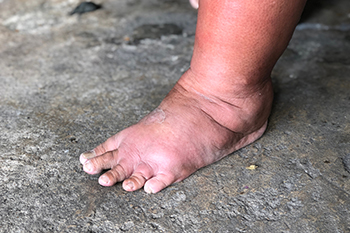Items filtered by date: February 2024
Dealing With Athlete’s Foot

Athlete's foot, or tinea pedis, is a common fungal infection. The fungi thrive in warm, moist places, such as locker rooms and communal showers. Symptoms of athlete's foot include intense itching, cracked skin, blistering, and redness, typically concentrated between the toes or on the soles of the feet. Diagnosing athlete's foot is usually straightforward, involving a thorough examination and discussion of lifestyle habits and footwear. Treatment requires patience, with antifungal medications often taking weeks to months for symptoms to fully resolve. Recurrence is common without proper foot care and preventative measures. To manage and prevent athlete's foot, it's essential to keep feet clean and dry, wear moisture-wicking socks and breathable shoes, and avoid walking barefoot in public areas. If you have a persistent case of athlete’s foot, it is suggested that you make an appointment with a podiatrist for personalized treatment and guidance.
Athlete’s Foot
Athlete’s foot is often an uncomfortable condition to experience. Thankfully, podiatrists specialize in treating athlete’s foot and offer the best treatment options. If you have any questions about athlete’s foot, consult with Henrietta Obidigbo, DPM from Jersey Foot and Ankle Clinic. Our doctor will assess your condition and provide you with quality treatment.
What Is Athlete’s Foot?
Tinea pedis, more commonly known as athlete’s foot, is a non-serious and common fungal infection of the foot. Athlete’s foot is contagious and can be contracted by touching someone who has it or infected surfaces. The most common places contaminated by it are public showers, locker rooms, and swimming pools. Once contracted, it grows on feet that are left inside moist, dark, and warm shoes and socks.
Prevention
The most effective ways to prevent athlete’s foot include:
- Thoroughly washing and drying feet
- Avoid going barefoot in locker rooms and public showers
- Using shower shoes in public showers
- Wearing socks that allow the feet to breathe
- Changing socks and shoes frequently if you sweat a lot
Symptoms
Athlete’s foot initially occurs as a rash between the toes. However, if left undiagnosed, it can spread to the sides and bottom of the feet, toenails, and if touched by hand, the hands themselves. Symptoms include:
- Redness
- Burning
- Itching
- Scaly and peeling skin
Diagnosis and Treatment
Diagnosis is quick and easy. Skin samples will be taken and either viewed under a microscope or sent to a lab for testing. Sometimes, a podiatrist can diagnose it based on simply looking at it. Once confirmed, treatment options include oral and topical antifungal medications.
If you have any questions, please feel free to contact our office located in Freehold, NJ . We offer the newest diagnostic and treatment technologies for all your foot care needs.
Are You Suffering From Nerve Damage?
Exploring Ankle Replacement Surgery

Ankle replacement surgery, a procedure designed to alleviate severe ankle pain and restore function, involves replacing damaged parts of the ankle joint with artificial components. This surgical intervention is typically recommended for individuals with advanced arthritis, significant joint damage, or debilitating pain that has not responded to conservative treatments. During the procedure, the podiatric surgeon removes damaged bone and cartilage from the ankle joint and replaces them with prosthetic components made of metal and plastic, mimicking the natural structure and function of the joint. Ankle replacement surgery aims to reduce pain, improve mobility, and enhance overall quality of life for individuals struggling with chronic ankle issues. Following surgery, patients undergo a period of rehabilitation to regain strength, flexibility, and range of motion in the ankle. If you are experiencing chronic ankle pain, it is suggested that you consult a podiatrist who can determine if ankle replacement is right for you.
Foot surgery is sometimes necessary to treat a foot ailment. To learn more, contact Henrietta Obidigbo, DPM of Jersey Foot and Ankle Clinic. Our doctor will assist you with all of your foot and ankle needs.
When Is Surgery Necessary?
Foot and ankle surgery is generally reserved for cases in which less invasive, conservative procedures have failed to alleviate the problem. Some of the cases in which surgery may be necessary include:
- Removing foot deformities like bunions and bone spurs
- Severe arthritis that has caused bone issues
- Cosmetic reconstruction
What Types of Surgery Are There?
The type of surgery you receive will depend on the nature of the problem you have. Some of the possible surgeries include:
- Bunionectomy for painful bunions
- Surgical fusion for realignment of bones
- Neuropathy decompression surgery to treat nerve damage
Benefits of Surgery
Although surgery is usually a last resort, it can provide more complete pain relief compared to non-surgical methods and may allow you to finally resume full activity.
Surgical techniques have also become increasingly sophisticated. Techniques like endoscopic surgery allow for smaller incisions and faster recovery times.
If you have any questions please feel free to contact our office located in Freehold, NJ . We offer the newest diagnostic and treatment technologies for all your foot and ankle needs.
Understanding Haglund’s Deformity

Haglund's deformity, an abnormality affecting the foot bone and soft tissues, can be recognized by a bony growth at the back of the heel, where the Achilles tendon is located. This enlargement, often referred to as a pump bump, can result in irritation of the adjacent soft tissue when it rubs against rigid shoes. Haglund’s deformity can lead to bursitis, a painful inflammation of the fluid-filled sac between the tendon and the bone. While this deformity can develop in anyone, it is most commonly observed in individuals who wear stiff, closed-heel shoes, particularly pump-style high heels. Several risk factors increase susceptibility to Haglund's deformity, including a high foot arch, a tight Achilles tendon, or a tendency to walk on the outside of the heel. Symptoms can include a noticeable bony bump on the back of the heel, severe pain where the Achilles tendon attaches to the heel, swelling in the bursa, and redness near the inflamed tissue. If you suspect you have Haglund's deformity, it is suggested that you schedule an appointment with a podiatrist for an evaluation and suggested treatment options.
Many people suffer from bouts of heel pain. For more information, contact Henrietta Obidigbo, DPM of Jersey Foot and Ankle Clinic. Our doctor can provide the care you need to keep you pain-free and on your feet.
Causes of Heel Pain
Heel pain is often associated with plantar fasciitis. The plantar fascia is a band of tissues that extends along the bottom of the foot. A rip or tear in this ligament can cause inflammation of the tissue.
Achilles tendonitis is another cause of heel pain. Inflammation of the Achilles tendon will cause pain from fractures and muscle tearing. Lack of flexibility is also another symptom.
Heel spurs are another cause of pain. When the tissues of the plantar fascia undergo a great deal of stress, it can lead to ligament separation from the heel bone, causing heel spurs.
Why Might Heel Pain Occur?
- Wearing ill-fitting shoes
- Wearing non-supportive shoes
- Weight change
- Excessive running
Treatments
Heel pain should be treated as soon as possible for immediate results. Keeping your feet in a stress-free environment will help. If you suffer from Achilles tendonitis or plantar fasciitis, applying ice will reduce the swelling. Stretching before an exercise like running will help the muscles. Using all these tips will help make heel pain a condition of the past.
If you have any questions please contact our office located in Freehold, NJ . We offer the newest diagnostic and treatment technologies for all your foot and ankle needs.
Causes and Symptoms of Swollen Feet

Understanding the causes of swollen feet, also known as edema, is important as this condition can signal other more serious ailments. Swelling of the feet is often accompanied by tenderness, pain, redness or warmth. In more severe cases, a decreased range of motion, difficulty breathing, and changes in skin color may occur. Injuries such as sprains and bruises frequently trigger swelling, as do infections like cellulitis. Chronic conditions like heart failure and kidney disease can lead to persistent edema, while pregnancy often causes swelling in the feet and ankles due to hormonal changes and increased blood volume. Allergic reactions and certain medications, like NSAIDs and steroids, can also induce swelling in the feet as a side effect. Treatment may include rest, elevation, compression therapy, medication adjustments, or medical interventions, such as drainage procedures or specialized footwear. If you are experiencing persistent swelling in the feet, it is suggested that you seek guidance from a podiatrist who can conduct an exam, identify the underlying cause, and recommend appropriate treatment.
Swollen feet can be a sign of an underlying condition. If you have any concerns, contact Henrietta Obidigbo, DPM of Jersey Foot and Ankle Clinic. Our doctor can provide the care you need to keep you pain-free and on your feet.
Swollen feet are a common ailment among pregnant women and people who stand or sit for extended periods. Aging may increase the possibility of swollen feet and patients who are obese often notice when their feet are swelling too. There may be medical reasons why swollen feet occur:
- Phlebitis - A condition that causes the veins to become inflamed and can also cause leg pain.
- Liver disease - This may lead to low blood levels of albumin which is a protein. This can cause fluid in the blood to pass into the tissues and several areas of the body can become swollen.
- Heart failure - When the heart doesn’t pump properly the blood that is normally pumped back to the heart can pool in the veins of the legs causing swollen feet.
- Kidney disease - One of the main functions of the kidneys is releasing excess fluid in the body. This type of condition can make it difficult for the kidneys to function properly, and as a result the feet may become swollen.
- Deep-vein thrombosis (DVT)- This is a serious condition where blood clots form in the veins of the legs. They can block the return of blood from the legs to the heart which may cause the feet to swell. It is important to be treated by a podiatrist if this condition is present.
Swollen feet can also be caused by bone and tendon conditions, including fractures, arthritis, and tendinitis. Additionally, there may be skin and toenail conditions and an infection may cause the feet to swell. Patients who take medicine to treat high blood pressure may be prone to getting swollen feet.
Many patients elevate their feet to help relieve the swelling and this is generally a temporary remedy. When a podiatrist is consulted the reason behind the swelling can be uncovered and subsequently treated.
If you have any questions please feel free to contact our office located in Freehold, NJ . We offer the newest diagnostic tools and technology to treat your foot and ankle needs.





